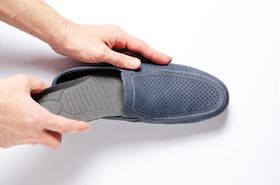Finding Comfort with Ice and Heat Therapy for Shin Splints
Updated December 18, 2024.

Shin splints, a common overuse-related condition, occur in the lower legs due to repetitive continuous exercise. Pain associated with this condition arises along the inner border of the tibia (shin) bone, where the muscles and bone tissues become inflamed and typically worsens with physical activity. Worn-out shoes or footwear lacking adequate support can also predispose people to this condition.
Symptoms of shin splints include pain along the inner aspect of the tibia, tenderness, and mild swelling in the same area. Shin splints can also cause pain during running or jumping activities. Treatment methods for managing this condition include rest, ice, compression, orthotics, and anti-inflammatory medications. Applying ice to the painful or tender area can reduce inflammation and pain, typically after physical activity. Initially, ice is the best option to reduce inflammation, while heat can be applied during later stages of healing to promote blood flow to the area.
Here are some basic tips on how and when you should apply ice and heat for shin splints.
» Want to prevent shin splints? Find the right insoles for you
Icing Shin Splints
Inflammation and pain associated with shin splints are normal responses to tissue damage. They're the body’s way of healing itself after an injury. Ice helps reduce swelling and inflammation along the shin bone to alleviate pain. It works by blocking and slowing down sensory receptors from the injured area to the brain.
Ice can be applied to the area for no longer than 15-20, after which it should be removed to allow the area to return to normal body temperature. It can be applied several times a day for 2-3 days following the injury or onset of pain. Ice therapy can be combined with massage and stretching techniques for best results.
Avoid applying ice directly to the skin to prevent irritation or itching. Note that ice should be used for inflammation and pain from the onset of the injury, and ensure you don't have any serious health conditions that affect the circulatory or sensory systems, such as diabetes, cardiovascular diseases, dermatitis, open wounds, or infections.
» Wondering if you have shin splints? Learn how to test yourself at home
Is Heat Good for Shin Splints?
heat therapy is not recommended immediately after an injury or the onset of pain as it can increase swelling and inflammation in the area, leading to increased pain. This treatment is suggested for pain lasting longer than one week following the initial onset. It is effective for alleviating pain and soreness in arthritic joints or tense/spasmed muscles. Heat increases blood flow to the injured area, bringing oxygen-rich blood and promoting faster healing.
Alternating heat and ice therapy can aid in pain control and improve healing. After applying heat, massage therapy can provide additional relief. Gentle stretches can also aid in pain management and healing once the area is warm.
Support Ice and Heat Therapy with the Right Orthotics
In treating and managing shin splints, heat and ice application is extremely beneficial in reducing pain and improving overall healing time. Alongside cold and heat therapy, custom orthotics are an effective and affordable way to manage shin splint symptoms and prevent future recurrence.
Upstep’s custom orthotics are cast in the comfort of your own home and manufactured by professionals using high-grade materials. They offer a wide range of choices for various foot conditions and sporting needs. Upstep custom orthotics come with a 120-day money-back guarantee and free shipping.








